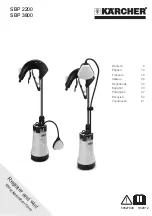
VRC Series IOM
10
IOM-M2-0316
Technical Support: (800) 789-8550
Part Number 478603
Refrigeration Connections
Both the condenser and ventilator unit are shipped
with a 20-psi nitrogen holding charge. Relieve
pressure before cutting or unsweating connection
stubs.
Filter drier, sight glass, liquid line solenoid, and
receiver are factory installed and do not need to be
field provided. Use ACR refrigeration copper pipe
only for interconnecting pipe.
Interconnecting refrigerant lines should be sized
according to the
Recommended Line Sizes
table on
page 11 unless the application dictates different line
sizes due to pressure drop or refrigerant velocity.
Consult the factory before changing line sizes.
Maximum vertical rise between the ventilator unit
and condenser is 60ʹ, with 100ʹ maximum, one way,
total equivalent line length. Equivalent line length is
equal to the straight pipe line length plus the straight
pipe equivalent of all the elbows and fittings. Consult
the factory for larger vertical or line runs.
Piping should be installed according to accepted
practices and codes (consult ASHRAE handbook).
Valent is not responsible for interconnecting piping.
Piping/Charging Procedure
▪
Relieve the 20-psi nitrogen holding charge from
both the ventilator unit and the condenser.
Relieve pressure from the Schrader port nearest
each connection. If no pressure is present, check
for leaks in the system.
▪
Run interconnecting pipe between the systems.
Discharge line horizontal piping runs should be
pitched in the direction of flow (1/2″ for every 10ʹ
of horizontal pipe). Clean and deburr all cut pipe
before connecting.
▪
Braze connections on each unit under nitrogen
purge to prevent the formation of copper oxide.
Wrap a wet cloth around the connection stubs
near the wall to protect the wall grommets.
▪
If the condenser is over 20ʹ above the ventilator
unit, an oil drip leg must be field installed at the
bottom of the first vertical rise in the discharge
line. If the discharge pipe contains multiple
vertical rises and horizontal sections, a drip leg
must be installed at the bottom of any rise over
10ʹ. Pipe the oil drip legs as shown in the
Refrigeration Piping Schematic
on page 12.
▪
Insulate the discharge line for safety (due to high
pipe temperatures). Insulate the liquid line if it is
to run through high-temperature areas (over 10°F
above outside air temperature).
▪
Use nitrogen to pressure check the system to 450
psi. System should hold pressure for one hour
with no significant pressure drop. Record pressure
check (psi) on the
Condenser Startup Form
on
page 16.
▪
Evacuate the system to 500 microns or less.
Record evacuation microns on the
Condenser
Startup Form
on page 16.
▪
Charge system to the following superheat and
subcooling with hot gas reheat at 0%. Use the
Charging Guidelines
on page 11 for guidance.
▪
Superheat: 10°F–20°F
▪
Subcooling: 10°F–15°F
Superheat should be measured at the suction line
port nearest to the compressor. Subcooling
should be measured at the liquid line port nearest
to the TXV. Refer to the
Approximate Charge
Chart
on page 11 for base charge and
approximate refrigerant addition per length of
interconnecting pipe.
Record the final charge on the
Condenser Startup
Form
on page 16. Record superheat and
subcooling values on the ventilator unit start up
form (VPR IOM PN#472916, Air-Cooled DX
Startup Form).
▪
Additional oil may need to be added to the system
based on interconnecting pipe length. On
compressors with an oil sight glass, the oil level
should settle between 20% and 80% full in the
sight glass after 15 minutes of steady-state
operation.
Oil should be fairly clear with minimal bubbles
during steady-state operation. Foggy oil indicates
the presence of liquid refrigerant and a possible
over-charge situation. If oil is low in the sight
glass, add oil to the system though the compressor
sump port or suction line port. Use POE oil only.
Record added oil amount on the
Condenser
Startup Form
on page 16.
▪
Use ventilator unit refrigeration start up form to
complete refrigeration start up (VPR IOM
PN#472916, Air-Cooled DX Startup Form).
Record all values requested.






































